April 11th, 2007
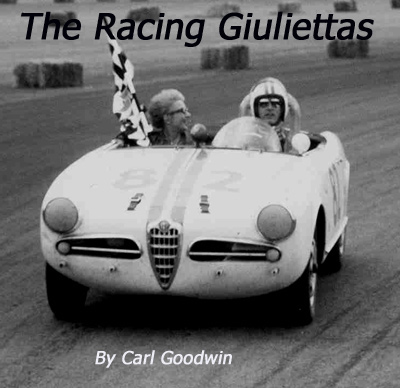
Barry Budlong of Rochester NY, takes the checkered flag around the Dunkirk NY airport race on June 1st 1958. Chuck Stoddard was initially in the lead. Both wre driving the new Alfa Giulietta Spider Veloces. Photo: Alix Lafontant.
|
Part I
A slow beginning
The Alfa Giulietta did not come on the sports car scene as Porsche did, with dramatic wins and startling performance. Instead, it kind of slid into the U.S. market, and began to race two years after its introduction in Italy.
The daunted marketing of distributor Max Hoffman was not as its best, as supplies of the new Alfa trickled into the �States. It was not for lack of interest, because everyone liked the little car right away.
Why wouldn�t they? The Giulietta had an impressive 1300cc twin-cam engine that was miles ahead of the MG-TD, with its same-side intake/exhaust, cast iron block and 3-main bearing crankshaft, and even the sophisticated Porsche. Technically, the new Alfa looked like a baby Ferrari, with its aluminum block and head. Transmission and differential cases were also aluminum. The coil-spring suspension had double A-arms in front and a live axle in the rear. It was located the same as the OSCA, with a centrally-mounted �A� frame. The brakes were beautiful alloy drums of enormous size, with diagonal fins on the fronts and radial fins on the rears. And that was just the �Normale.� The Veloce model was introduced in 1956. It had twin-choke Webers replacing the downdraft Solex carburetor, 9.7-to-1 forged pistons, high lift camshafts and a large-capacity oil pan with flapper gates and a windage tray.
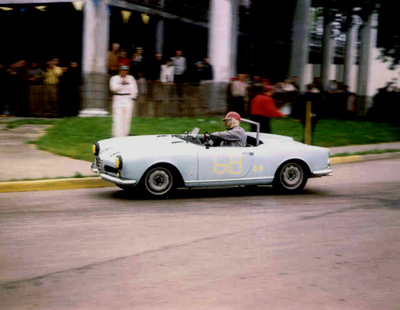
Ralph Durbin's Alfa #68 exits the corner at the Roundhouse Bar at Put-in-Bay in 1957. Photo: Joe Brown.
|
You could have your choice of three lightweight Giulietta body styles: the terrific-looking Bertone-desgined coupe (�Sprint�) introduced in late 1954, the stunning Pininfarina convertible (�Spider�) in 1956 or a nifty 4-door sedan with the same great engine but column shift.
The trouble was, you couldn�t buy these cars. No dealers. One early racer, Henry Wessells, bought his car, an early Spider model, on a used car lot in Miami. Another racer, Jack Downey, bought his on a used car lot in Ypsilanti, Michigan. Ken Askew, who drove Downey�s car in races, recalls visiting a Porsche dealer with the new Giulietta coupe. �I drove it over to Sports Cars of Ypsilanti,� he says, �and showed it to Ed Hancock there. Ed looked it over and drove it, then said �This will never be successful as a racing car.� Of course that made us all the more determined that it would be a success and in our first race � at Put-in-Bay, June 9th - we were 2nd to Chuck Dietrich in an F-Modified Lester-MG. The night before the �Bay race, I took MG driver Ralph Durbin around the course and he was so impressed he became an Alfa dealer. Durbin�s was the only place you could get a new Alfa in the Detroit area.� A couple of weekends later, at the Road America June Sprints, an Alfa Giulietta beat a Porsche 1300, leaving Ed Hancock to reconsider his appraisal.
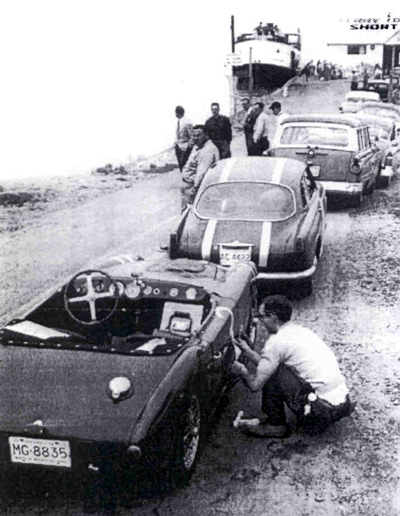
Early Alfa racer Ken Askew (in dark shirt and jacket) waits for the ferry boat to take his Alfa Sprint coupe to Put-in-Bay in 1956. His friend Don Black, later Alfa's head engineer in the U.S., applies the number 3 to his Siata Spyder. Photo: Collection of Ken Askew.
|
�After the island race, we ran Haven Hill, a Michigan hillclimb, and were 1st there,� Ken Askew continues, �then we were 2nd in the International Nabex, a 24-hour rally in Canada that Jack drove, and we entered the Mobil Gas Economy run, where we got 60 miles to a gallon. Jack was a truck fleet owner and he figured out that you could make a Giulietta run on one barrel of the Solex carburetor. We put 55 pounds of pressure in the tires and used a driving technique that involved accelerating to 80 miles an hour and coasting with the engine off, then restarting when we got back to 30 mph. The organizers disqualified us because they didn�t believe we could get a mileage figure that good.
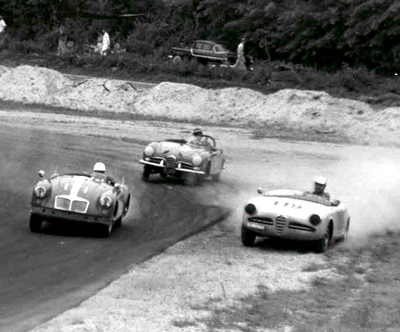
At the inaugural race at Lime Rock in 1957, Alfa #119 was apparently trying an outside pass on the dark MG when he ran out of room. Photo: Alix Lafontant.
|
Giuliettas on the track
�When the Alfas began winning races, Tom Payne brought in a couple of Porsche 1300 Supers to give us some competition. This was a little controversial because those cars weren�t supposed to be available in the �States. I think Frank Cipelle was one of the drivers. Al Allen and I were running Alfas against the Porsches. They looked down on us, so we felt we had to respond. Besides the Porsches, I felt confident to run with TR3s and Morgans as well as Healeys, until they came out with the 3000.�
The month after Put-in-Bay, July 20-21, 1956 saw a spirited Alfa-Porsche race at the Brynfan Tyddyn course. Longtime Alfa racer and collector Henry Wessells was gridded against Emil �Pup� Pupulidy's dealer-supported black Porsche 1300 coupe in G-Production. Wessells� car was such an early version that it sported a column gear selector (rather than the standard production floor shift) and Rudge knock-off wheels.
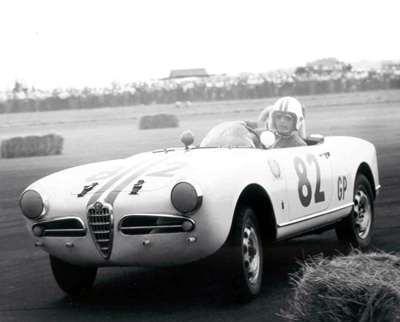
A picture of concentration as Barry Budlong heads for a win at Dunkirk, 1958. Photo: Alix Lafontant.
|
The lead changed several times on the hilly, dangerous three-and-a-half mile road course. Recognizing the hazards of the course, with its rocks, ditches and trees, officials had limited engine size to 2-liters and had a number of no-passing zones in the worst parts of the course. �Just before the finish,� Wessells recalls, �there was a no-passing zone, and after it I passed Emil. Then just before the checkered flag, Pupulidy squeaked ahead. Officials questioned the pass but decided to let the results stand.�
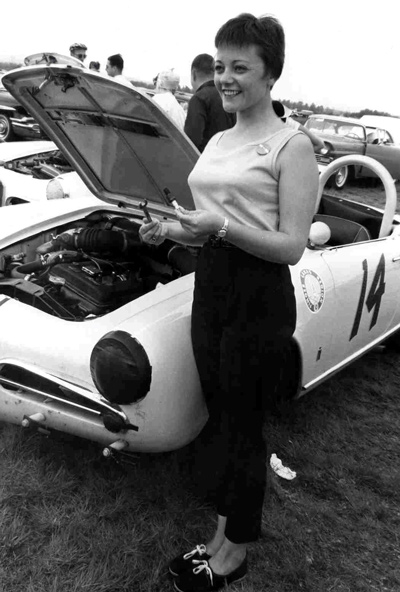
"There's carbon on this sparkplug," the Alfa lady seems to be saying. Dunkirk 1958. Photo: Alix Lafontant.
|
So the racing potential of the new Alfa was beginning to make itself known. The Alfa entries at Put-in-Bay, the island course in Ohio, were a microcosm of early Giulietta racing. After Ken Askew�s race in 1956, Ralph Durbin took a 1st in his Giulietta Spider in 1957, then in 1958 Chuck Stoddard raced his Spider at the �Bay and got two prizes: 1st in class and the Blow-Up Trophy. Chuck explains: �I had started my car business by then, and Max Hoffman wouldn�t sell you Porsches unless you bought Alfas. I liked the Alfa and decided to race it � there were no 1300 Porsches racing at the Bay then, but plenty of Alfas. While leading on the last turn of the last lap, I downshifted and blew up the engine. The crankshaft broke, in a cloud of white smoke. I had the presence of mind to stick in the clutch and coast over the finish line for the win.�
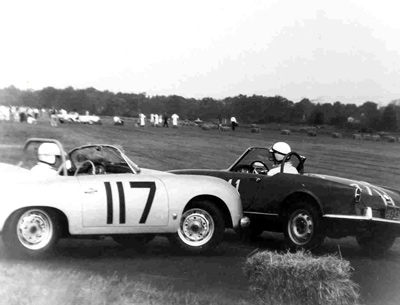
Alfa #11 gets a little crossed up in front of a Porsche at Dunkirk, 1958. Photo: Alix Lafontant.
|
Enter Ed Hugus
Another early race for the Alfa was the first race at the new Bridgehampton course. Racing photographer Alix Lafontant was there, on September 29, 1957 : �Tony Briggs led the first three laps but as he was pushed by a determined red Veloce driven by Ed Hugus, Briggs spun in the downhill turns and Hugus moved up. At the end of the race, Hugus was so far ahead that he was practically pacing himself to the finish line when on the 13th lap his left front wheel parted company with the car and took off on a surveying trip over the sand piles.�
Ed Hugus recalls the incident: �It was on the second turn at the bottom of the hill. The center pulled out of the wheel. It must have been fatigue. That Alfa brake drum was big enough to roll on and I finally came to a stop.�
�I drove the Alfa for a man named Bill Speer � not Spear, the Cunningham driver. Speer was a German craftsman and I became like his adopted son. As soon as he got the car, he took it all apart and opened up the clearances. There was three thousandths of piston clearance. When you first started it, it would rattle and bang. Then, after it warmed up it was tremendously fast. It was car #13, my lucky number.
�After Bridgehampton, we went to Watkins Glen and won the Chieftan�s Cup. Then we went to Cumberland and won there. We won at Dunkirk, too, and another course in eastern New York. There we had the race in the bag but the brake lining gave out and we had to settle for second. It was a defective lining. I wanted to race at Riverside and I was an Alfa dealer, so Max Hoffman arranged for me to drive a car from Los Angeles. It was a pig and we came in second � my own car would have won it.
�Before the Alfa, I had a Cooper Bobtail that John Bentley and I drove at Le Mans � I later sold it to Tom Hallock in Grosse Pointe. I stopped racing the Alfa to drive a 2-liter Ferrari � a 500 Mondial � for Chet Flynn. It was the car that Temple Buell in Denver bought for Masten Gregory to drive.�
The author would like to thank Dean Russell and his sidekick Jim at Trail Auto in Dearborn Heights, Michigan. Their website is www.trailalfa.com
Portions of this story previously appeared in Sport Car International magazine.
Read Part II
For a list and urls of more articles about Alfas and Giuliettas, click here:
Alfa Articles.



